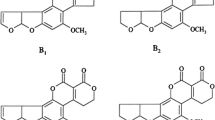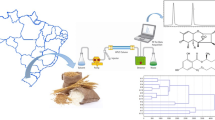Abstract
Peanut and its processed products are recurrently contaminated with aflatoxins (AFs) which are of potential public health concern. Among the different types of AFs, Aflatoxin B1 (B1) is the most frequently detected in peanuts over the maximum level (ML), and thus has warranted considerable research interest in the domain of food safety. In this study, we investigated the decontamination of B1 in three naturally-incurred lots (4, 12, and 40 µg/kg) of peanuts by a range of cooking treatments, including frying, pressure cooking, and roasting. B1 concentrations were determined by ultra-high performance liquid chromatography- fluorescence detection. The method provided a limit of quantification of 0.25 µg/kg for B1, which was much lower than any of its national and international MLs. The recoveries of B1 in fresh and cooked peanuts (positive-control) were in the range of 90–100%. Overall, all the cooking methods demonstrated a significant reduction in B1 loads. The degree to which the processing methods reduced the B1 content followed the pattern: roasting with a combination of NaCl and citric acid > pressure-cooking with a combination of NaCl and citric acid > frying. As the cooking procedures did not involve any complicated steps or sophisticated equipment, these could be readily adopted for decontamination or reduction in the level of B1 for a safer consumption of peanuts at the household level without affecting the organoleptic properties.


Similar content being viewed by others
References
Abdel-Wahhab MA et al (2007) Zizyphusspina-christi extract protects against aflatoxin B1-intitiated hepatic carcinogenicity. Afr J Tradit Complement Altern Med 4:248–256
Arzandeh S, Jinap S (2011) Effect of initial aflatoxin concentration, heating time and roasting temperature on aflatoxin reduction in contaminated peanuts and process optimisation using response surface modelling. Int J Food Sci Technol 46:485–491
CODEX STAN 193–1995. General standard for contaminants and toxins in food and feed (CODEX STAN 193–1995). www.fao.org/input/download/standards/17/CXS_193e_2015.pdf
Das C, Mishra H (2000) Effects of aflatoxin B1 in detoxification on the physiochemical properties and quality of ground nut meal. Food Chem 7:483–487
Diedhiou PM, Ba F, Kane A, Mbaye N (2012) Effect of different cooking methods on aflatoxin fate in peanut products. Afr J Food Sci Technol 3:53–58
EC 1881/2006 (2006) Official Journal of the European Union, L364, pp 5–24. https://eur-lex.europa.eu/legal-content/EN/TXT/PDF/?uri=CELEX:32006R1881&from=EN
EC 401/2006 (2006). Official Journal of the European Union, L 70,pp 12–34. https://www.fsvps.ru/fsvps-docs/ru/usefulinf/files/es401-2006.pdf
FSSAI (2011). Food safety and standards, contaminants, toxins and residues regulations, 2011 Available at https://fssai.gov.in/home/fss-legislation/fss-regulations.html
International Agency for Research on Cancer, (IARC) (2002). Some traditional herbal medicines, some mycotoxins, naphthalene, and styrene. IARC Monographs. Vol. 82, IARC, Lyon
Jalili M (2016) A review on aflatoxins reduction in food. Iran J Health Saf Environ 3:445–459
Kaushik G (2015) Effect of processing on mycotoxin content in grains. Crit Rev Food Sci Nutr 55:1672–1683
Larmond E (1970) Methods of sensory evaluation of food. Can Deptt Agric Pubs: 1284–1290
Lee LS, Cucullu AF, Franz AO Jr, Pons WA Jr (1969) Destruction of aflatoxins in peanuts during dry and oil roasting. J Agric Food Chem 17:451–453
Lisker N, Michaeli R, Frank ZR (1993) Mycotoxigenic potential of Aspergillus flavus strains isolated from groundnuts in Israel. Mycopathologia 122:177–183
Méndez-Albores A, Arambula-Villa G, Loarca-Piña MGF, Castano-Tostado E, Moreno-Martínez E (2005) Safety and efficacy evaluation of aqueous citric acid to degrade B-aflatoxins in maize. Food Chem Toxicol 43(2):233–238
Mobeen AK, Aftab A, Asif A, Zuzzer AS (2011) Aflatoxins B1 and B2 contamination of peanut and peanut products and subsequent microwave detoxification. J Pharm 1(1):1–3
Ogunsanwo BM, Faboya OOP, Idowu OR, Lawal OS, Bankole SA (2005) Effect of roasting on the aflatoxin contents of Nigerian peanut seeds. Afr J Biotechnol 3:451–455
Oulkar D, Goon A, Dhanshetty M, Khan Z, Satav S, Banerjee K (2017) High-sensitivity direct analysis of aflatoxins in peanuts and cereal matrices by ultra-performance liquid chromatography with fluorescence detection involving a large volume flow cell. J Environ Sci Health Part B 53:255–260
Panalaks T, Scott PM (1977) Sensitive silica gel-packed flow cell for fluorometric detection of aflatoxins by high pressure liquid chromatography. J Assoc Off Anal Chem 60:583–592
Park JW, Kim YB (2006) Effect of pressure cooking on aflatoxin B1 in rice. J Agric Food Chem 54:2431–2435
Pluyer HR, Ahmed EM, Wei CI (1987) Destruction of aflatoxins on peanuts by oven-and microwave-roasting. J Food Prot 50:504–508
Rapid Alert System for Food and Feed. Available at https://ec.europa.eu/food/sites/food/files/safety/docs/rasff_annual_report_2016.pdf
Rastegar H, Shoeibi S, Yazdanpanah H, Amirahmadi M, Khaneghah AM, Campagnollo FB, Sant’Ana AS, (2017) Removal of aflatoxin B1 by roasting with lemon juice and/or citric acid in contaminated pistachio nuts. Food Cont 71:279–284
Saalia FK, Phillips RD (2011) Degradation of aflatoxins by extrusion cooking: effects on nutritional quality of extrudates. LWT - Food Sci Technol 44:1496–1501
Samarajeewa U, Sen AC, Cohen MD, Wei CI (1990) Detoxification of aflatoxins in foods and feeds by physical and chemical methods. J Food Prot 53(6):489–501
Acknowledgements
We thank Dr Suparna Banerjee for offering us the content development, and writing support. We wish to extend our thankfulness to Dr Ankita Lakade, and Dr Anindita Paul for their technical comments.
Author information
Authors and Affiliations
Corresponding author
Ethics declarations
Conflict of interest
The authors have no conflict of interests.
Additional information
Publisher's Note
Springer Nature remains neutral with regard to jurisdictional claims in published maps and institutional affiliations.
Electronic supplementary material
Below is the link to the electronic supplementary material.
Rights and permissions
About this article
Cite this article
Dhanshetty, M., Elliott, C.T. & Banerjee, K. Decontamination of aflatoxin B1 in peanuts using various cooking methods. J Food Sci Technol 58, 2547–2554 (2021). https://doi.org/10.1007/s13197-020-04761-3
Revised:
Accepted:
Published:
Issue Date:
DOI: https://doi.org/10.1007/s13197-020-04761-3




